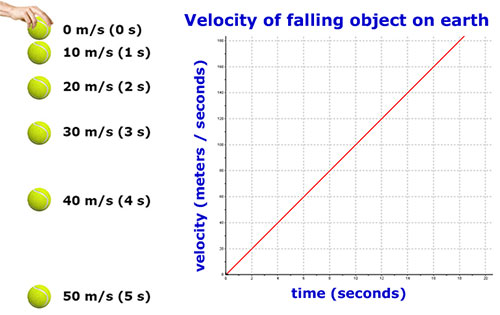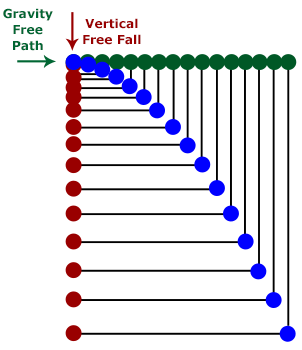Learn
Two-Dimensional Motion
As was mentioned in the introduction of this lesson, most objects move in two dimensions instead of a straight line. Think about the movement of different sports balls, for example.
- A basketball shot toward a goal
- A football passed downfield
- A volleyball set to a hitter
They all have aspects of two-dimensional motion! They all move both horizontally and vertically.

You should realize that measurements (such as distance and displacement) in a straight line can easily be added together; however, when the displacements are not in the same direction or opposite directions, they cannot be added or subtracted. This means that two-dimensional motion calculations are slightly more difficult than those involving simple, straight-line motion.
But don't worry! For now, it is more important that you understand and recognize two-dimensional motion. As you move to more advanced science courses, you will discuss the calculations for this type of motion.
In the rest of this lesson, we will examine one of the main types of two-dimensional motion: projectile motion. However, before looking at projectile motion, it's important that you understand the concept of free fall motion. The next portion of the lesson will cover that in detail before moving on to projectile motion.
Free Fall
Free fall is the motion of an object when gravity is the only force acting on it. When an object is falling on the Earth, it is accelerated toward the Earth at 9.8 m/s2. This is equal to 22 mph/s downward. This is called standard gravity, and it's represented by g = 9.8 m/s2. Sometimes it is referred to as the standard acceleration due to gravity or the standard acceleration of free fall.
Watch the video Falling 101 (9:57) to learn about common misconceptions about gravity and free fall. Login information.
When you drop a ball straight down, it will accelerate at 9.8 m/s/s this is read as “9.8 meters per second per second” , or 9.8 m/s2. Each second the object falls, its velocity increases by 9.8 m/s.
The diagram below uses 10 m/s instead of 9.8 m/s for ease of counting. Notice how the velocity changes each second. Beside the example is a chart graphing the velocity of the ball.

Take a very close look at the chart above, which graphs the ball's velocity. We will examine these types of graphs more closely in the upcoming lessons but, for now, you should recognize that this graph demonstrates that velocity is changing at a constant rate (hence the straight line).
- Every second the velocity increases by 10 m/s, which can easily be seen on the graph.
- So after 5 seconds, the velocity has increased to 50 m/s.
Weightlessness and Free Fall
Without air resistance, all objects would fall to the ground at the same rate, no matter the size or weight of the objects. However, air resistance, drag, and other factors influence falling objects on Earth, causing different objects fall to the ground in different amounts of time.
For example, if you dropped a feather and a rock at the same time, the rock will hit first before the feather. This is due to air resistance pushing up on the feather. If the same objects were dropped on the Moon, they would hit the ground at the same time. This is because there is no air resistance on the Moon.
To learn more about free fall, weightlessness, and air resistance, watch the following videos:
- Law of Falling Bodies (4:05) Login instructions.
- Galileo on the Moon (8:50) Login information.
Projectile Motion
What do baseball, softball, volleyball, football, and shot put all have in common? They all have objects that move in projectile motion during play. Any object that is hit or thrown is considered to be a projectile.
Watch the video Motion of a Projectile (2:21) to learn more. Login instructions.
We know that when a ball is hit or thrown, it can move vertically (go up) and horizontally (move over) in a curved path. Because we live on the Earth, gravity causes projectiles to follow a curved path. This curved motion is called parabolic motion.

Water sprayed upwards is now falling in droplets in an arc, which is the shape of a parabola.
When you throw a baseball, the force exerted by your hand gives the ball horizontal velocity. After releasing the baseball, its horizontal velocity is constant. Once the ball leaves your hand, a force is no longer acting on the ball. The ball will succumb to gravity. Gravity causes it to accelerate downward, increasing its vertical velocity. The result of these two motions is the curved path. The horizontal and vertical motions are completely independent of each other.
In the diagram below:
- The red dots show the path of a ball in vertical free fall, meaning it only shows gravity pulling the ball straight down vertically with no horizontal movement.
- The green dots show the path of a ball in a gravity-free environment, where the ball would travel horizontally at a constant velocity. In this gravity-free scenario, there would be no vertical velocity because there would be nothing pulling the ball downwards.
- The blue dots show the trajectory or actual motion of the ball on the Earth. The ball experiences the pull of gravity and exhibits both vertical and horizontal velocity, resulting in a curved path.


